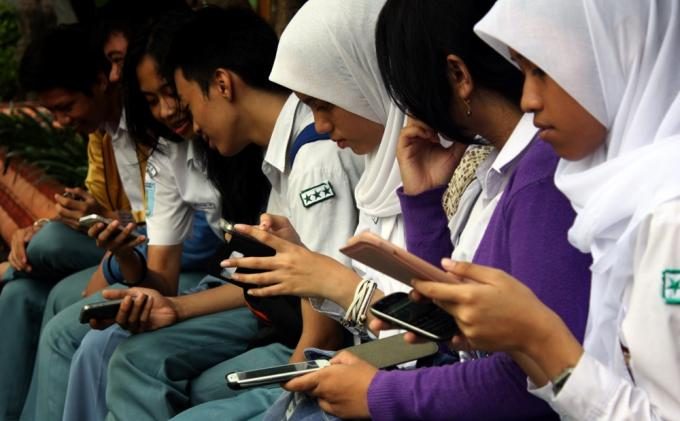New technology may bring Australia and Indonesia closer. But it also has a darker side, write Edwin Jurriens and Ross Tapsell.
The two most defining trends facing our current generation of young Australians are the rise of Asia as an economic power, and the digital revolution. This calls for two urgent types of literacy: Asia literacy and digital literacy.
The dynamic capacity of the Internet to connect and transmit information – as well as the evolving nature of devices and infrastructures, owing to digitalisation – has seen new technologies bring rapid change to the world. Australia has long seen China, Japan and Korea as places of technological innovation, but less is known about how these enormous trends affect our nearest neighbours, Indonesia.
The developments in the region confirm that Asia literacy and digital literacy are two phenomena that are not distinct from each other, but in fact closely interrelated. Digital technology is at the core of life, work, culture and identity in Indonesia, a young nation with a median age of 28 and a rapidly growing urban middle class with purchasing power and consumer lifestyles.
There are 64 million Indonesians with a Facebook account, the fourth highest in the world, while 20 million Indonesians have a Twitter account, the third highest in the world. Jakarta has been named the world’s “most active city on Twitter”. Officially, Indonesia’s internet penetration remains around 30 per cent, with around four-fifths of the country’s internet users on the islands of Java and Sumatra. Yet this figure is expected to grow considerably in the next decade.
One survey states that Indonesians spend an average of five hours a day online, with this amount much higher in bigger cities where citizens face long commutes to work. In 2011, of the 55 million Indonesians who were connected to the Internet, around 33 per cent did so via mobile phones. By 2016, that figure was estimated at 79 per cent.
Yet with both mobile phone usage and Internet access, there remains great disparity. Less than 40 per cent of Papuans owned a mobile phone, compared with an estimated 97 per cent of Jakartans. Bridging the digital divide remains a huge challenge for the Indonesian government, but if done successfully, will have profound impact on the country’s economy, society and culture.
How does an increasingly digital Indonesia affect, expand or hinder relations with Australia?
A stable, prosperous, democratic Indonesia is at the core part of Australia’s foreign policy. Politically, digital platforms have been used to organise mass rallies, assist with election monitoring, and generally provide a space for greater freedom of opinion and expression on a variety of issues and events, contributing in no small way to the country’s rambunctious democracy.
President Jokowi, who came to power with the help of many young volunteers promoting his campaign online, has led Indonesia’s capacity for investment in the so-called digital economy. When Malcolm Turnbull visited Jakarta last year, Jokowi explained to him that by 2020 the forecast of Indonesia’s digital economy will be $US130 billion.
But behind the glossy sell of social-media driven campaigns, tech start-ups and e-commerce growth, “disruptive” digital technologies present significant challenges. They have affected the media, banks, terrorism networks, disaster relief, city planners, as well as education, labour unions, informal sector employment, artistic production and much more.
Indonesia is increasingly becoming a haven for cybercrime. And not all those who speak their mind online are treated well. In one high-profile example, Sumatran public servant Alexander A’an started a Facebook page for atheists in 2012, which led him to be attacked by an angry mob and later found guilty of “disseminating information aimed at inciting religious hatred or hostility”. He was given a two-and-a-half year jail sentence.
Digital technology is rapidly changing the face of Indonesia. Middle-class Muslims use Facebook, WhatsApp, LINE, Telegram and BlackBerry Messenger to form social groups and discuss everyday religious issues. This includes online consultations with their favourite religious preachers about topics ranging from Islamic jurisprudence to marital problems.
The digital transfer of knowledge is also crucial for the broader community of Indonesian students and researchers. In March 2016, the National Library (Perpustakaan Nasional) launched IndonesiaOneSearch, a mobile friendly and interoperable system to index all sorts of collections, including journals and existing library systems and institutional repositories. Initiatives such as IndonesiaOneSearch are not only invaluable sources for Indonesian schools and universities, but also for promoting and developing Asia literacy among Australian youth.
Indonesians often joke that Australia’s interests in their country are the three Bs: beef, boats and Bali. But these are largely short-term fixations fuelled by recurring diplomatic spats. Beyond these surface issues lies both enormous opportunities and challenges for a new generation of Asia literates and digital natives. Now is the time for our two countries to embark on this endeavour.
Edwin Jurriens (Melbourne University) and Ross Tapsell (ANU) are scholars with longstanding interests in Indonesia. They are co-convening this year’s Indonesia Update at ANU on 16-17 September, with the theme of Digital Indonesia: challenges and opportunities of the digital revolution.
This article was also published in The Canberra Times.
 Facebook
Facebook  Twitter
Twitter  Soundcloud
Soundcloud  Youtube
Youtube  Rss
Rss 